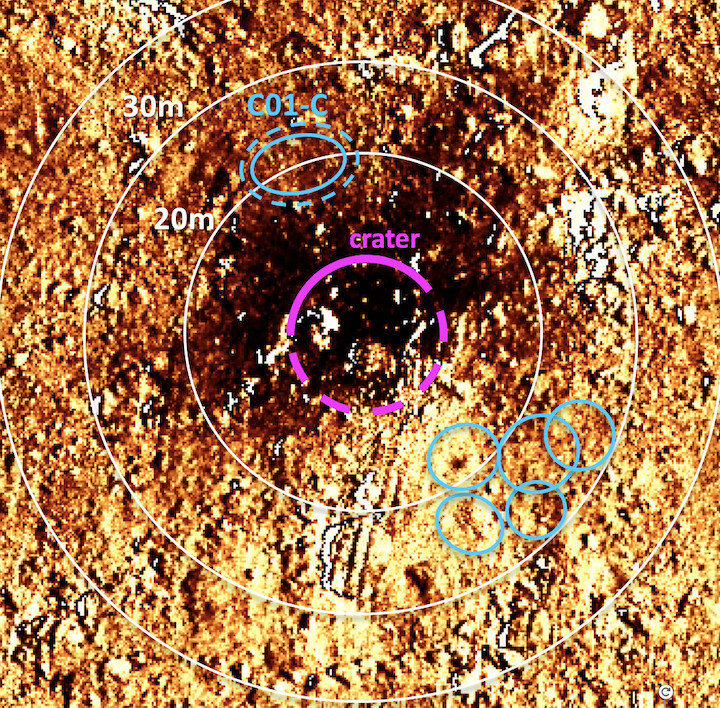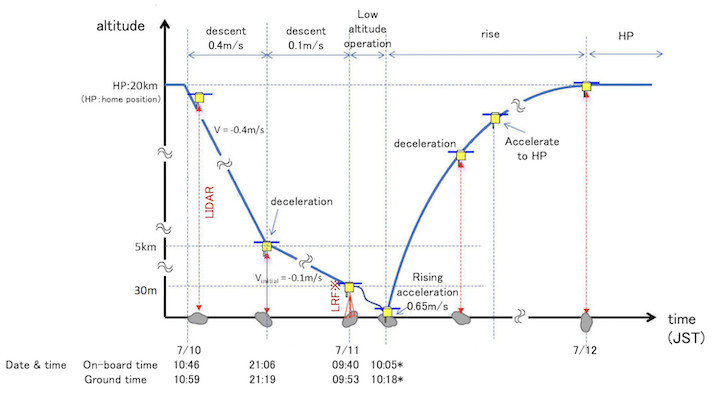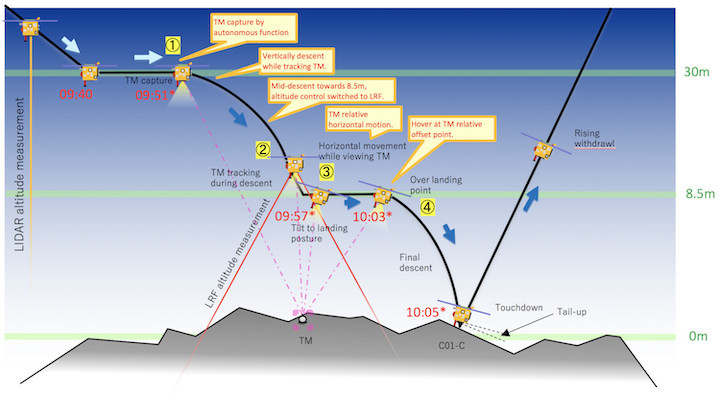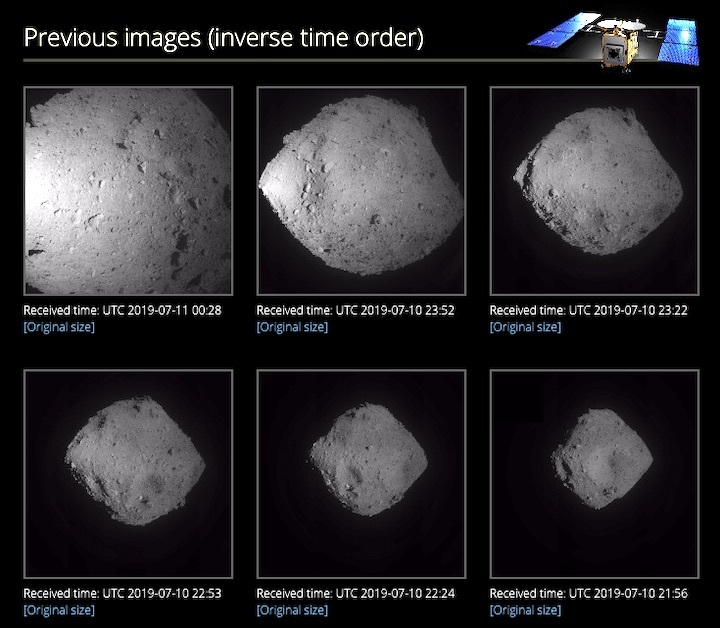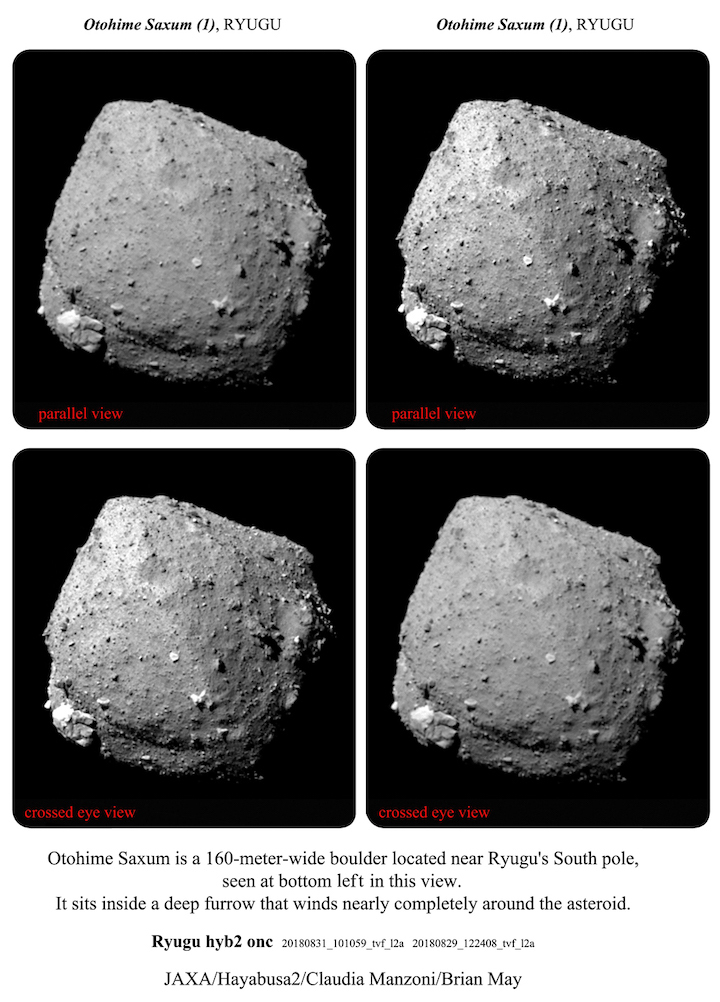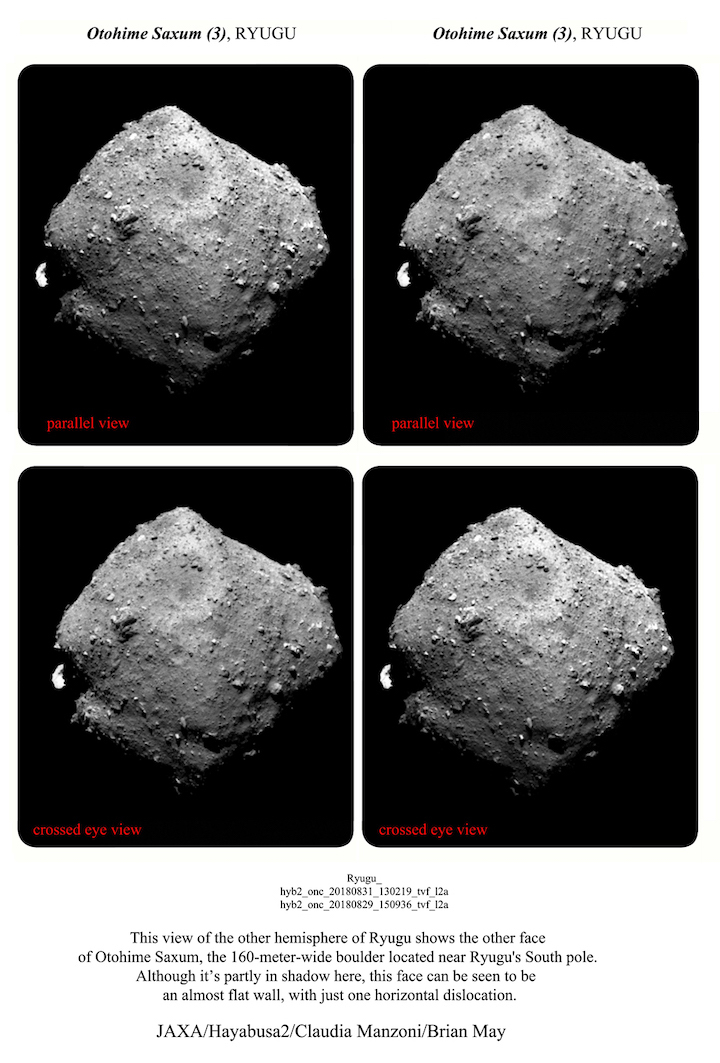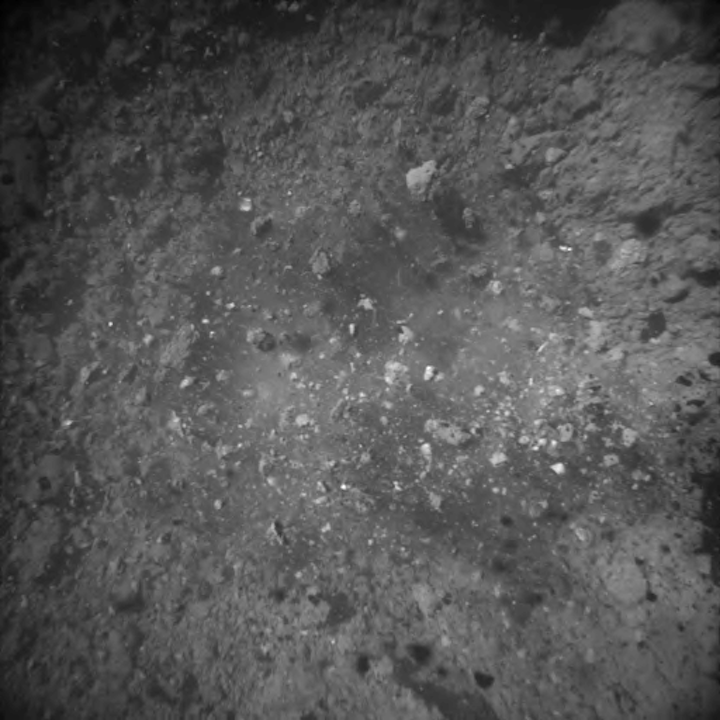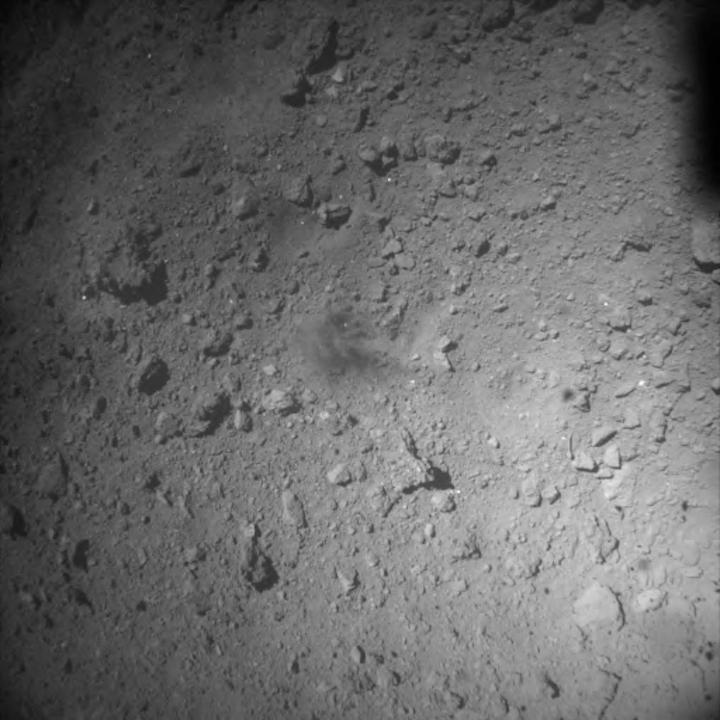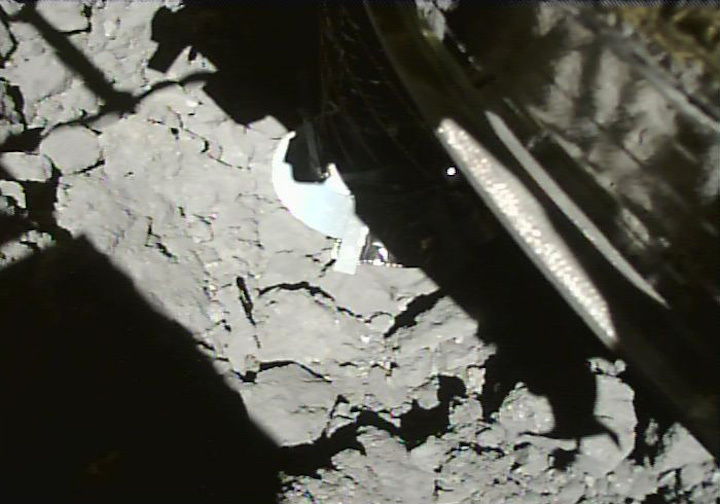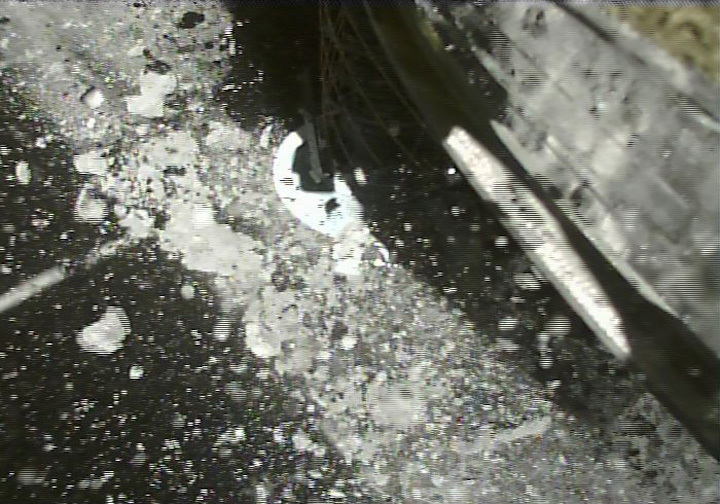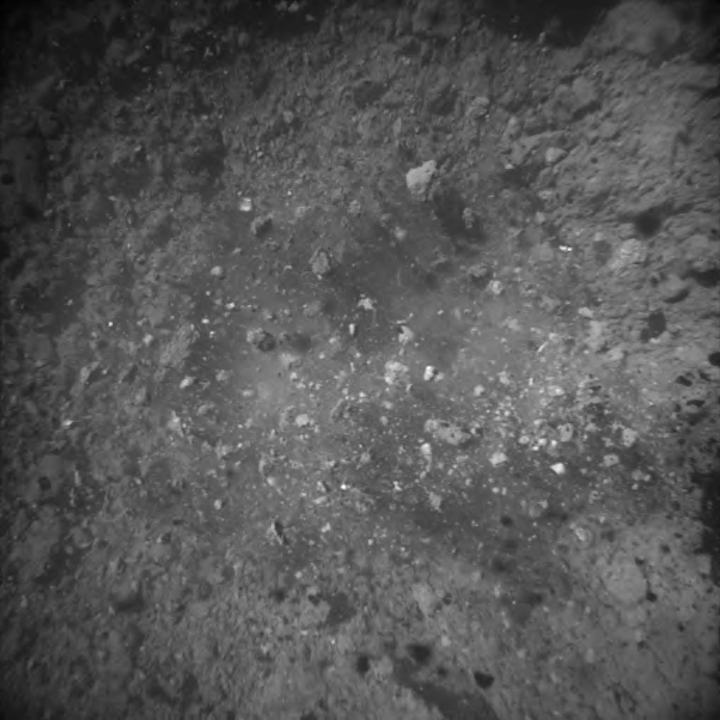A camera has successfully recorded a Japanese spacecraft’s attempt to grab a second sample from a distant asteroid. While the actual sample collection happened earlier in July, a video made of images taken during the maneuver was just released on Friday, July 26th.
The sample-collecting spacecraft, Hayabusa2, has been in orbit around the asteroid Ryugu since July 2018, and it has already delivered robots and rovers to the asteroid. In the new video, you can see the shadow of the spacecraft grow steadily as it nears the surface of the asteroid. As the outstretched sample-collecting limb makes contact, a flurry of dust and rocks explodes from the surface while the spacecraft quickly ascends back into space.
The video (which is sped up by about 10 times) documents the second time that the spacecraft has grabbed a sample of the asteroid. It’s also the second time that an onboard camera — CAM-H, which was entirely funded by public donations — captured the sample-collecting action.
A blog post on Hayabusa2’s official website mentioned the potential danger of the second collection attempt. The combination of unfriendly terrain, technical difficulty of the maneuver, and the fact that the spacecraft was operating so far from Earth left Hayabusa2’s mission control with no room for error. As the team pointed out, just because they’d successfully nabbed a sample in February didn’t guarantee a similarly good outcome with this next attempt.
They decided to try anyway, figuring that all of those risks were substantially outweighed by the potential scientific riches that awaited if they could collect a second sample. Unlike the first attempt, this time, the team was aiming to nab material from the asteroid’s interior, which hasn’t been subjected to as much radiation as its surface.
Back in April, Hayabusa2 blasted a crater into Ryugu’s surface, exposing material from the inside of the asteroid to space. Pictures of the crater were sent back to Earth a few weeks later, allowing researchers to figure out where fresh material from the impact had landed and if they could safely make an effort to collect it. They decided it was with the risk.
Besides, “being vaguely anxious does not make any progress.” the anonymous blog authors noted.
Hayabusa2 has been making progress on its mission since it launched in December 2014. The spacecraft is finally scheduled to start its journey home in either November or December. It should arrive at Earth sometime in late 2020, at which point, it will send its precious samples hurtling down through the atmosphere as souvenirs from a very long and eventful trip.
Quelle: The Verge
----
Update: 23.08.2019
.
For an asteroid, Ryugu has surprisingly little dust on its surface
The space rock may hide the fine debris inside larger rocks or eject it into space
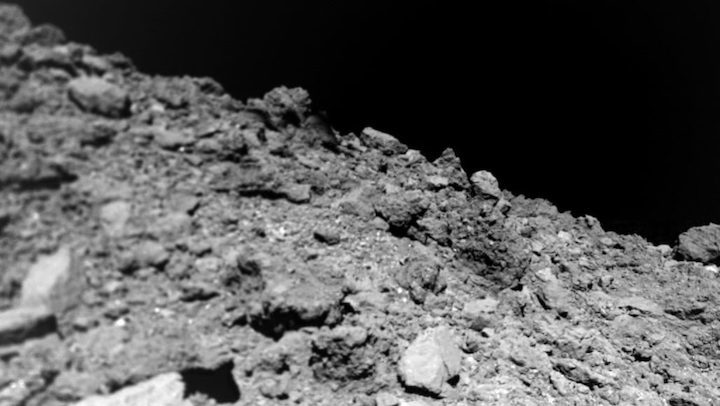
Germany’s MASCOT probe took this photo just before landing on the asteroid Ryugu. The craft found a landscape of crumbly and jagged rocks, but not much actual dust.
Ryugu is a neat freak. The surface of the small, near-Earth asteroid is surprisingly free of dust, observations from Germany’s MASCOT lander show.
The asteroid, thought to have formed from the breakup of a larger body around 700 million years ago, has no atmosphere to protect it from interplanetary dust streaming through the solar system (SN: 4/27/19, p. 4). These miniature missiles pummel exposed space rocks at high speed, breaking down their surfaces into thin layers of dust and dirt, such as those found on the moon and the asteroid Vesta.
But when MASCOT bounced across Ryugu in October 2018 (SN Online: 9/24/18), the lander took high-resolution photos that show no sign of any dust-sized particles, down to a resolution of about 100 micrometers, about the thickness of a sheet of paper, researchers report in the Aug. 23 Science.
“After a few tens of millions of years, you should have dust on the surface,” says planetary scientist Ralf Jaumann of the German Aerospace Center in Berlin. “If it’s not there, you should have some kind of physical, geological processes which clean up these bodies.”
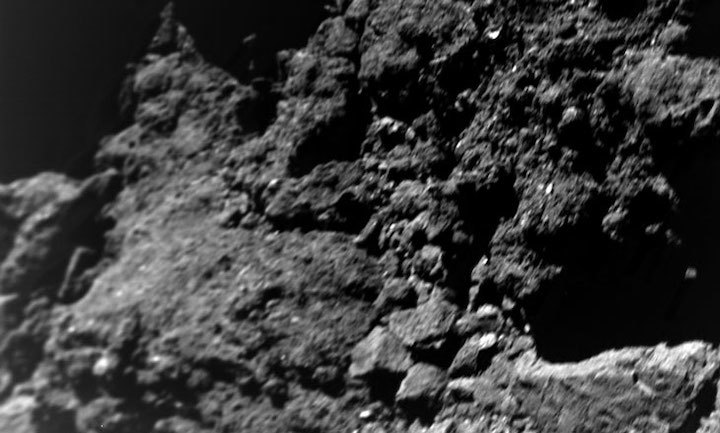
The MASCOT lander took many pictures as it bounced over Ryugu’s surface, and revealed a rugged terrain largely free of dust.
Ryugu could hide its dust in larger, porous rocks or deep in its interior, Jaumann and colleagues say. Shaking due to a meteorite impact may shuffle the particles into bigger surface rocks or down through small surface cracks to the asteroid’s center and out of sight, the way small nuts end up at the bottom of a cup of trail mix.
Or Ryugu could spray dust into space when sunlight heats patches of trapped ice and releases volatile gases. A similar asteroid, Bennu, seems to spew plumes of small rocks into space, according to NASA’s OSIRIS-REx spacecraft (SN: 4/13/19, p. 10). But Jaumann thinks that explanation is less likely for Ryugu. Observations from the Japanese Hayabusa2 craft, which has been orbiting Ryugu since June 2018 and brought MASCOT along, suggest that Ryugu has less water in its minerals than Bennu (SN: 1/19/19, p. 6).
There’s another possible explanation for Bennu’s dust sprays, says OSIRIS-REx principal investigator Dante Lauretta of the University of Arizona in Tucson. He thinks frequent temperature changes on Bennu’s surface as the different sides of the asteroid rotate in and out of sunlight could make the asteroid’s larger rocks fracture like a snapped cracker, spraying crumbs into space.
If something similar happens on Ryugu, “then Ryugu should also be ejecting particles,” he says. Hayabusa2 may just not be in the right position to see the sprays. “It would be very cool if we saw it.”
But snapping rocks might create more dust, not less, he notes. An answer to the mystery may not come until after Hayabusa2 returns to Earth with samples of Ryugu’s surface and subsurface in late 2020 (SN: 8/17/19, p. 14).
Quelle: ScienceNews
+++
The near-Earth asteroid Ryugu – a fragile cosmic 'rubble pile'
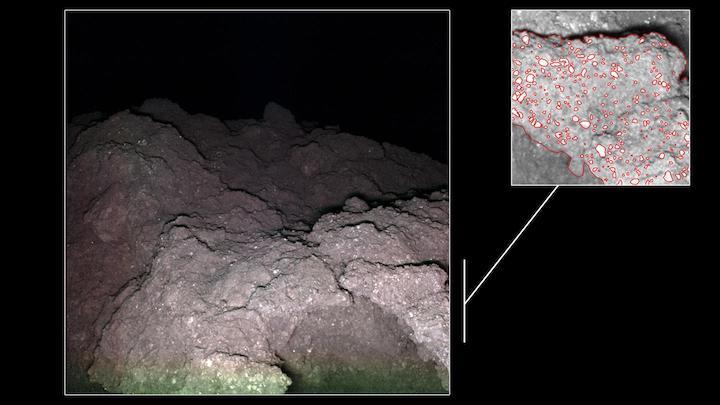
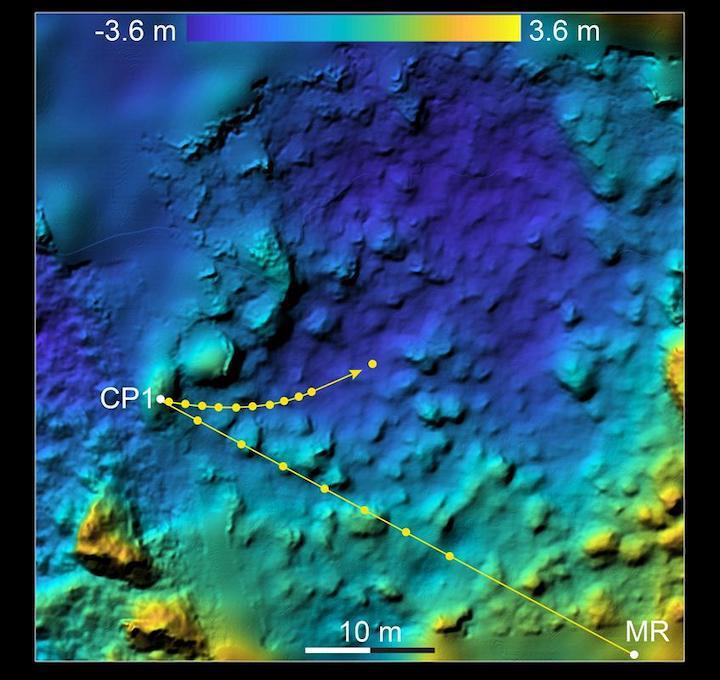
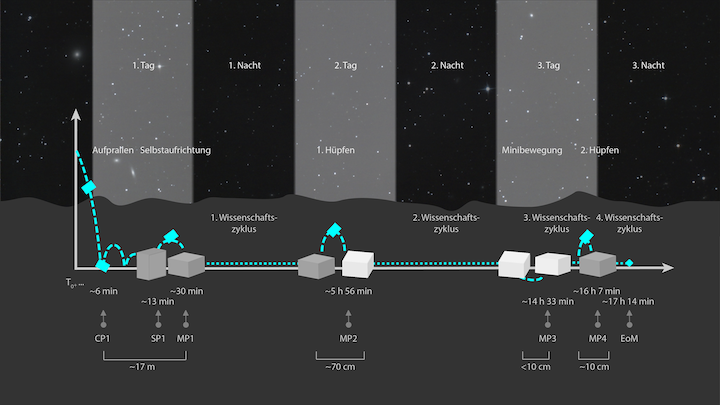
n the summer of 2018, the asteroid Ryugu, which measures only approximately 850 metres across, was visited by the Japanese Hayabusa2 spacecraft. On board was the 10-kilogram German-French Mobile Asteroid Surface Scout (MASCOT) – a lander no bigger than a microwave oven and equipped with four instruments. On 3 October 2018 MASCOT, operated by the control centre at the German Aerospace Center (Deutsches Zentrum für Luft- und Raumfahrt; DLR) in Cologne, separated from its mother craft 41 metres above the asteroid. It touched down on the surface for the first time six minutes after deployment, before coming to a halt 11 minutes later, like a dice on a board game moving in slow motion. Over the course of 17 hours, MASCOT carried out experiments in various places amid the large boulders. Evaluation of the image data from DLR's MASCOT camera (MASCam) showing the descent and Ryugu’s surface has now revealed a detailed view of a fragile 'rubble pile' made up of two different, almost black, types of rock with little internal cohesion. The scientific team, led by planetary researcher Ralf Jaumann from the DLR Institute of Planetary Research in Berlin-Adlershof, have now reported on this in the current issue of Science.
"If Ryugu or another similar asteroid were ever to come dangerously close to Earth and an attempt had to be made to divert it, this would need to be done with great care. In the event that it was impacted with great force, the entire asteroid, weighing approximately half-a-billion tonnes, would break up into numerous fragments. Then, many individual parts weighing several tonnes would impact Earth," says Jaumann, who is supervising the MASCam experiment, interpreting the observations. The asteroid is very similar to carbonaceous meteorites found on Earth, which date back 4.5 billion years. With an average density of just 1.2 grams per cubic centimetre, Ryugu is only a little 'heavier' than water ice. But as the asteroid is made up of numerous pieces of rock of different sizes, this means that much of its volume must be traversed by cavities, which probably makes this diamond-shaped body extremely fragile. This is also indicated by the measurementsconducted by the DLR MASCOT Radiometer (MARA) experiment, which were published recently.
Scientists writing space history
"The evaluation of the MASCOT experiments is yielding highly interesting results. To me, it is fascinating to see what this small, high-tech box has achieved on Ryugu, an asteroid 300 million kilometres from Earth," enthuses Hansjörg Dittus, DLR Executive Board Member for Space Research and Technology. "With MASCOT, we have written a small chapter of space history with our Japanese and French colleagues."
MASCOT 'hopped' across the surface using an internal swing arm. "Upon landing and arrival at the initial location, MASCOT had to perform a manoeuvre to correctly align the scientific instruments with the asteroid surface," explains MASCOT Project Manager Tra-Mi Ho of the DLR Institute of Space Systems in Bremen. "This was followed by three more changes in position, with additional measurements."
Two different types of rock, but no dust
The boulders that can be seen in the images acquired by the camera during MASCOT’s descent and on the surface are mostly dark and measure between 10 centimetres and one metre across. Although most of them are angular, some are smooth. Boulders with level, fractured surfaces and sharp edges are slightly lighter in colour than those with more irregular, cauliflower-like and partially crumbly surfaces. On average, Ryugu reflects only 4.5 percent of the incident sunlight, comparable with charcoal, making it among the darkest objects in the Solar System. MASCam was able to acquire images throughout the day and even at night. The camera system was equipped with light-emitting diodes for this purpose, which illuminated the immediate surroundings in different, clearly defined colour wavelengths in visible light and near-infrared, in order to record the reflective behaviour of their environment in different spectral channels.
The two types of rock observed are distributed approximately equally over Ryugu's surface. This suggests two possible origins: "Firstly," explains Jaumann, “Ryugu could have been formed following the collision of two bodies made of different materials. As a result, it would have broken up, before the fragments came together under the influence of gravity to form a new body made up of the two different types of rock. Alternatively, Ryugu could be the remnant of a single body whose inner zones had different temperature and pressure conditions, thus resulting in the formation of two types of rock.”
Ralf Jaumann and his team were particularly surprised by the lack of dust: "Ryugu's entire surface is littered with boulders, but we have not discovered dust anywhere. It should be present, due to the bombardment of the asteroid by micrometeorites over billions of years, and their weathering effect. However, as the asteroid has very low gravity – only one-sixtieth of that experienced on Earth’s surface – the dust has either disappeared into cavities on the asteroid or has escaped into space. This gives an indication of the complex geophysical processes occurring on the surface of this small asteroid.”
Boulders reminiscent of materials from the primordial solar nebula
Until now, the MASCOT scientists believed that Ryugu was similar to two meteorites that fell to Earth in 1969 in Allende, Mexico, and Murchison, Australia. However, those meteorites barely contain bright particles, probably due to the weathering effect of water in the crystal grid of these minerals. The bright inclusions that have now been observed have led the scientists to conclude that Ryugu's cauliflower-like rocks bear greater similarities to meteorites from Tagish Lake. On 18 January 2000, hundreds of small meteorites rained down on Earth following the explosion of a large fireball over Canada, and numerous fragments were found on the ice of the frozen lake.
These are very rare stony meteorites from what is referred to as the CI chondrite class. The C stands for the chemical element carbon, and the I for the similarity with the Ivuna meteorite found in Tanzania. They are among the oldest and most primitive components of the Solar System, remnants of the first solid bodies to be formed in the primordial solar nebula.
Ryugu is a 'Near-Earth Object' (NEO) – that is, an asteroid or comet that comes close to or intersects Earth’s orbit. In some cases, these might be on a collision course with Earth. Ryugu's orbit around the Sun is almost coplanar to that of Earth and approaches it at an angle of 5.9 degrees to within a distance of approximately 100,000 kilometres. Ryugu will never come within the immediate vicinity of Earth, but knowing the properties of bodies like Ryugu is of great importance when it comes to assessing how such Near Earth Objects (NEOs) could be dealt with in the future.
Preparing for the return to Earth
While the MASCOT sub-mission was being completed, Hayabusa2 carried out numerous manoeuvres, mapped the asteroid at high resolution and collected samples from various parts of the surface with a sampler horn. These were then sealed in a transport container that will embark on its return journey in December 2019. The samples will then descend through the atmosphere and land on Earth in 2020.
About the Hayabusa2 mission and MASCOT
Hayabusa2 is a Japanese space agency (Japan Aerospace Exploration Agency; JAXA) mission to the near-Earth asteroid Ryugu. The German-French lander MASCOT on board Hayabusa2 was developed by the German Aerospace Center (Deutsches Zentrum für Luft- und Raumfahrt; DLR) and built in close cooperation with the French space agency CNES (Centre National d'Études Spatiales). DLR, the Institute d'Astrophysique Spatiale and the Technical University of Braunschweig have contributed the scientific experiments on board MASCOT. The MASCOT lander and its experiments were operated and controlled by DLR with support from CNES and in constant interaction with the Hayabusa2 team at JAXA.
The DLR Institute of Space Systems in Bremen was responsible for developing and testing the lander together with CNES. The DLR Institute of Composite Structures and Adaptive Systems in Braunschweig was responsible for the stable structure of the lander. The DLR Robotics and Mechatronics Center in Oberpfaffenhofen developed the swing arm that allowed MASCOT to ‘hop’ on the asteroid. The DLR Institute of Planetary Research in Berlin contributed the MASCAM camera and the MARA radiometer. The asteroid lander was monitored and operated from the MASCOT Control Center in the Microgravity User Support Center (MUSC) at the DLR site in Cologne.
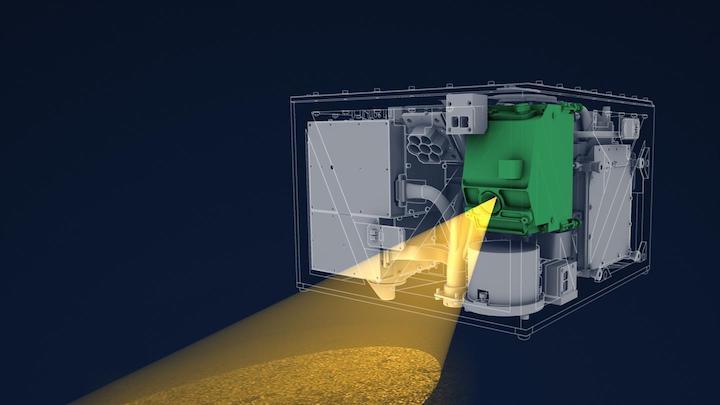
Quelle: DLR
----
Update: 27.08.2019
.
New images from asteroid probe yield clues on planet formation
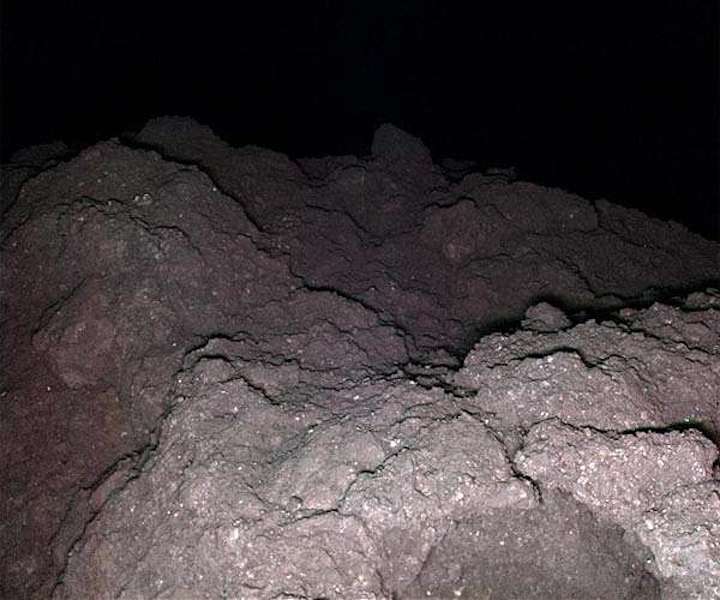
Ryugu at night - a 'cauliflower rock' with bright minerals | The MASCam team identified two types of rock in the images acquired during MASCOT's MASCOT and landing. Some were slightly brighter (but also only reflected five percent of the incident sunlight); these were 'Type 2' boulders with sharp edges and smooth, fractured surfaces. Others were darker, reflecting only four percent of the incident solar irradiation; these were more irregularly shaped 'Type 1' boulders with cauliflower-like, crumpled surfaces. The latter were imaged during the first night at Ryugu, directly in front of the MASCam lens, and they were illuminated with the built-in light-emitting diodes. A combination of blue, green and red light was used to create this colour image. The researchers were surprised by brightly reflecting minerals reminiscent of calcium- and aluminium-rich splinters of a rare class of meteorites, the 'CI-Chondrites', which fell to Earth at Tagish Lake in Canada in 2000. They are among the oldest and most original witnesses of the formation of the Solar System found in meteorite collections on Earth. On the upper right, the enlarged section of the rock spur on the lower right in the large image, which was about 25 centimetres in front of MASCam.
Photographs snapped by a shoebox-sized probe that explored the near-Earth asteroid Ryugu offer new clues about its composition, insights that are expected to help scientists understand the formation of our solar system.
The German-French Mobile Asteroid Surface Scout (MASCOT) was dropped off by Japan's Hayabusa2 spacecraft on October 3, 2018, free-falling from a height of 41 meters (135 feet) for six minutes before it hit the surface.
It then bounced a couple of times -- reaching a height of 17 meters on the first bounce -- before coming to rest.
Ryugu is just 900 meters wide and so its gravity is 66,500 times weaker than Earth's. Had MASCOT been equipped with wheels, its forward motion would have launched it back into space.
Instead, it hopped around the surface using the tiny amount of momentum generated by a metal swing arm attached to its boxy body, which weighed 10 kilograms (22 pounds).
In addition to taking temperature readings and other measurements, MASCOT sent back a series of pictures showing the asteroid is covered with two types of rocks and boulders: dark and rough ones with crumbly surfaces resembling cauliflowers, and bright and smooth ones.
"The interesting thing there is, it really shows that Ryugu is the product of some kind of violent process," Ralf Jaumann of the German Aerospace Center told AFP. He is the lead author of a paper describing the findings, published Thursday in the journal Science.
Ryugu may be the "child" of two parent bodies that collided, broke up and were then pulled back together by gravity, the researchers say.
Alternatively, it could have been struck by another body that created different interior temperature and pressure conditions, creating the two types of material.
Many of the rocks contain small blue and red "inclusions" -- material trapped in the rock during its formation -- much like a type of rare, primordial meteorites found on Earth called carbonaceous chondrites.
"This material is primitive material -- it's the very first material of the solar nebula," or the cloud of interstellar dust and gas that formed the planets of our system, said Jaumann.
Hayabusa2, which set off from Earth in 2014 and itself touched down twice on the asteroid's surface, most recently in July, will arrive home next year carrying samples for analysis in the lab.
MASCOT's observations provide, for the first time, information on the material's original geologic context, including how it is exposed to temperature changes and how it is "weathered" in space.
"We don't know how planets formed in the beginning," said Jaumann.
"And in order to understand this, (we must) go to the small bodies, these primitive bodies, primordial in their history in their evolution, in order to understand the first 10 to 100 million years of planetary formation."
- A dust mystery, and a future threat? -
MASCOT also presented scientists with a new mystery: its lack of fine particles, or interplanetary dust, which would normally accumulate through millions of years of space weathering.
The paper offered theories but no definitive conclusions.
The dust might have fallen into tiny holes in Ryugu's surface when the asteroid was struck by other bodies.
Alternatively, temperature changes could have resulted in an electrostatic force that expelled the dust into space. Or water might once have existed on Ryugu, and its evaporation would have carried away the smaller particles.
There's another reason to study asteroids: humankind's survival could one day depend on it.
Ryugu's orbit places it mainly between Earth and Mars. Though it comes close, it's not thought to pose a danger to us, but other asteroids could.
If their composition is like Ryugu's, trying to take them out with a missile would probably just break them into smaller rocks still headed toward Earth.
One possibility would be to build a large, reflective solar sail and place it on the asteroid's surface, so that the pressure from solar radiation would gradually alter its course, said Jaumann.
Whatever strategy is adopted, he and other astronomers say it's clear these small, enigmatic bodies are of not-so-small importance in our solar neighborhood.
Quelle: SD
+++
Japan's Hayabusa2 Asteroid Probe Packs Its Space-Rock Bag for Return to Earth
An image captured by the Hayabusa2 spacecraft after the second sampling procedure.
Japan's Hayabusa2 spacecraft has packed up the capsule that will ferry its precious space-rock cargo back to Earth in preparation to leave the asteroid Ryugu later this year.
It's just one step completed by the Japan Aerospace Exploration Agency (JAXA) spacecraft as the agency turns its attention to the return phase of the mission.
Hayabusa2 completed its second and final sampling maneuver in July. The endeavor's completion likely means that the spacecraft's three-chamber sample storage mechanism is full up, with bits of rock from both the surface and the interior of Ryugu.

Today (Aug. 26), JAXA confirmed that the sampling chamber has now been stored inside the re-entry capsule, which will be the only part of the spacecraft to return to Earth. That capsule should arrive home in late 2020.
On its return voyage, the re-entry capsule will make its way through Earth's atmosphere to land in the Woomera Protected Area of South Australia's outback. Japan has been working with Australia to acquire permission to install an antenna to track the capsule's location and collect the capsule there, according to JAXA.
Earlier this month, JAXA also heard from one of the two small hopping roversthat Hayabusa2 deployed to Ryugu's surface in September. According to JAXA press materials, both of those hoppers woke up; the mission team is considering what to do with them.
The main Hayabusa2 spacecraft carries one more small rover, called MINERVA-II2, which the team plans to deploy later this fall; a rehearsal is scheduled for Sept. 5.
That deployment is the spacecraft's last task before it turns back to Earth for the year-long journey to cart its precious space-rock cargo home to the scientists eagerly awaiting the special delivery in 2020.
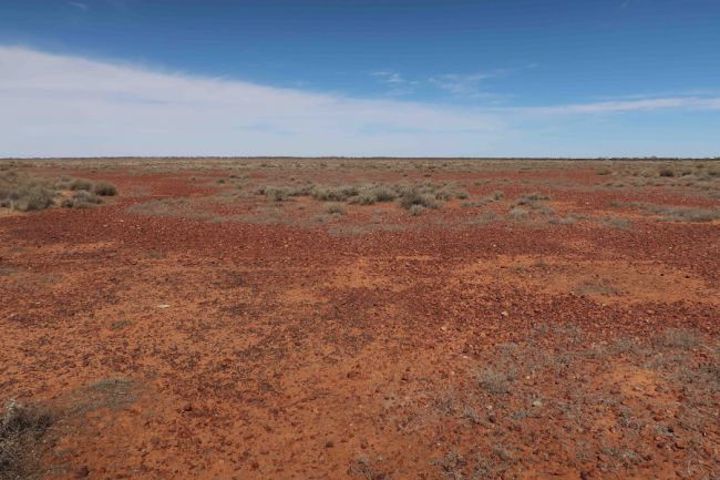
JAXA is planning to pick up the Hayabusa2 re-entry capsule in the Woomera Prohibited Area in the outback of South Australia.
Quelle: SC

